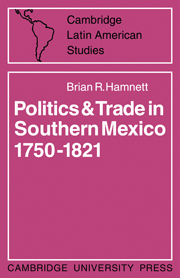Book contents
- Frontmatter
- Contents
- Acknowledgments
- Archival abbreviations
- Weights, measures, and currency
- Introduction
- 1 Oaxaca—environment and trade
- 2 The struggle for control of trade
- 3 The problem of reform, 1768–1786
- 4 Reform and reality—the crisis of the subdelegations in the 1790s
- 5 The Gálvez Plan under fire, 1786–1804
- 6 Finance, trade, and the merchants, 1789–1808
- 7 The political crisis of 1808–1821
- 8 Conclusion—Oaxaca within the context of Mexican politics
- Glossary of Personnel
- Appendices
- Sources and bibliography
- Maps
- Index
2 - The struggle for control of trade
Published online by Cambridge University Press: 04 August 2010
- Frontmatter
- Contents
- Acknowledgments
- Archival abbreviations
- Weights, measures, and currency
- Introduction
- 1 Oaxaca—environment and trade
- 2 The struggle for control of trade
- 3 The problem of reform, 1768–1786
- 4 Reform and reality—the crisis of the subdelegations in the 1790s
- 5 The Gálvez Plan under fire, 1786–1804
- 6 Finance, trade, and the merchants, 1789–1808
- 7 The political crisis of 1808–1821
- 8 Conclusion—Oaxaca within the context of Mexican politics
- Glossary of Personnel
- Appendices
- Sources and bibliography
- Maps
- Index
Summary
Spain faced considerable foreign competition for the Mexican dye. For, England, France, and Holland possessed a greater capacity of consumption. As a result, the Viceroyalty of New Spain, in many respects, was a producer of bullion and primary products for the European countries with a more advanced industry than Spain. Their power, economic in character, operated behind the shadow of political control exercised by Madrid. In anxious reaction to such a detrimental situation, Spanish Governments since the constitution of the Junta de Comercio in Madrid in 1679 had been preoccupied with the recovery of national control over the Indies trade. Parallel to this commercial policy the Spanish Ministers and writers, especially after the accession of Philip V in 1700, advocated the advancement of Spanish industrial activities, especially textiles.
Until such reforms could be brought to successful fruition, the wealth of the Oaxaca merchants and their seniors in the Consulado of Mexico was secured principally not so much by trading to the Spanish national textile factories, but to those of Spain's main competitors for the export trade to the Indies. Whether through the legitimate trade to Seville or Cádiz, or through the notorious contraband trade, the merchants of New Spain were the recipients of foreign manufactures. The merchants of Seville and Cádiz, for their part, often acted as the intermediary factors in the drain of both bullion and dyes through the Spanish Peninsular entrepôt to northern Europe.
- Type
- Chapter
- Information
- Politics and Trade in Mexico 1750–1821 , pp. 24 - 40Publisher: Cambridge University PressPrint publication year: 1971



